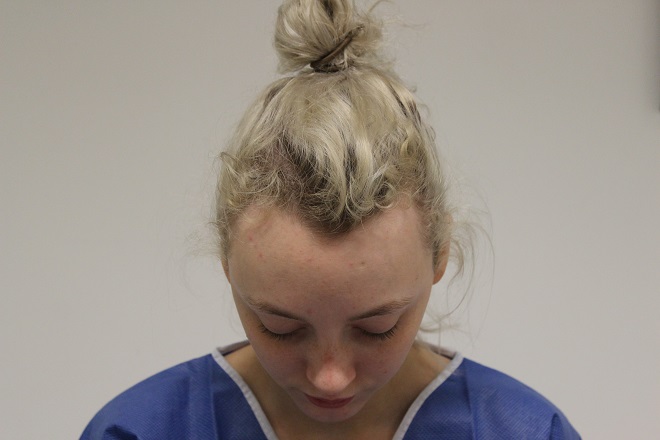Receding hairline in women: causes and treatments
20th October 2024

In the past, a receding hairline has typically been associated with men. However, hair loss is a common concern amongst women too, and many women also experience the frustrations and anxiety of a receding hairline.
Many aspects of daily life can be distressing when suffering from a receding hairline, but it can be managed and treated with the right approach. In this blog, we’ll explore the signs and causes of a receding hairline in women, and dive into the treatments options available to help restore and maintain healthy hair.
What is a receding hairline in women?
Hair loss can manifest in different ways, including thinning and widening of a parting, patchy bald spots, or a receding hairline. Although less common than in men, a receding hairline in women is still a significant issue that can arise from a variety of causes.
A receding hairline refers to the gradual backward movement of the hairline, often leading to visible thinning at the front of the scalp. In men, a receding hairline is normally caused by androgenetic alopecia, otherwise known as male pattern baldness. This is a genetic condition, typically causing a gradual loss of hair along the forehead and temples, leading to a characteristic “M” shape hairline.
However, a receding hairline in women usually follows a less distinct pattern, sometimes presenting as even recession across the forehead, or just with loss in the corners of the hairline. In some cases, a receding hairline can present as a deep “M” shape similar to male recession.
What causes a receding hairline in women?
Whereas pattern baldness is the main cause of a receding hairline in men, a receding hairline in women might be caused by a variety of factors and may be a feature of another hair loss condition. Below are some of the main causes of hair loss in women:
- Genetics: Androgenetic alopecia (female pattern baldness) is a genetic condition which leads to hair loss. Although it doesn’t typically manifest as a receding hairline in women, it can contribute to a receding hairline over time, particularly at the corners of the hairline.
- Hormonal changes: Women regularly experience hormonal changes. For instance, changes during pregnancy, menopause, and childbirth can contribute to changes in the hair.
- Hairstyles: Traction alopecia is a hair loss condition which occurs when the hair is frequently put under tension, for instance, with tight hairstyles, extensions or weaves. Over time, this strain weakens hair follicles, causing hair at the hairline to fall out or thin.
- Medical conditions and medications: Certain medical conditions can cause hair loss. For instance, alopecia areata is an autoimmune disorder which results in patchy hair loss. Other conditions like lupus, anaemia, thyroid disorders, and polycystic ovary syndrome (PCOS) have also been linked to hair loss in women. Additionally, chemotherapy drugs and various medications can also lead to hair loss in some women, including drugs for blood pressure or depression.
- Nutritional deficiencies: Poor diet and deficiencies in vitamins and minerals can weaken hair follicles, resulting in thinning or hairline recession.
- Stress: Physical and emotional stress can also lead to hair loss, including a receding hairline. Stress can trigger a condition called telogen effluvium, which pushes hair follicles into a resting phase, leading to excessive shedding. Although this type of hair loss is often temporary, it can exacerbate or contribute to an existing receding hairline.
- Trichotillomania: A condition which leads to compulsive hair pulling.
- Frontal fibrosing alopecia (FFA): An uncommon condition which causes hair loss at the front and sides of the scalp. It is more common in post-menopausal women, so may be related to hormonal changes. But other potential causes include genetics, autoimmune disorders, or environmental factors.
Diagnosing a receding hairline in women
In women, a receding hairline is often gradual and subtle at first, making it tricky to detect. However, there may be some early signs of hair loss to look out for:
- Thinning at the temples
- Excessive hair shedding
- Slow hair growth
- A more visible scalp
- Hairs in temples becoming shorter, fluffy or more difficult to style
- Increased hair breakage
If you’re concerned about a receding hairline or are noticing any of the signs above, it’s essential to get a proper diagnosis from a hair loss specialist. At The Maitland Clinic, our comprehensive diagnostic process involves:
- Personalised assessment of your symptoms, hair health, and concerns
- Scalp analysis with advanced trichoscopy imaging techniques
- Diagnosis and discussion of treatment options
- Customised treatment plan
Early diagnosis allows for more effective treatment options, so it’s important to seek help as soon as you notice the first signs of hair loss.
Treatments for a receding hairline in women
Your hair loss diagnosis will guide which treatment might be most effective for you. We strongly believe that any kind of hair loss surgery should only be considered when someone is the right candidate for a hair restoration procedure.
Non-surgical treatments
Hair loss medication may help to stabilise a receding hairline in women. There are many different types of hair loss medication, so it’s important to see a hair loss specialist to learn which is best for you.
Laser therapy and platelet-rich plasma (PRP) may also help to reduce the rate of hair loss and stop a receding hairline from getting worse.
Surgical treatments
Non-surgical options work to slow down total hair loss, so they can be a great option for those in the earlier stages of loss. However, if a receding hairline is relatively advanced with sufficient gaps present, a surgical hair restoration treatment may be considered to lower or thicken a receding hairline.
At The Maitland Clinic, we offer the Follicular Unit Transplant (FUT) and the Follicular Unit Excision (FUE) techniques. Both treatments involve taking hair grafts from a donor area, where the hair is genetically programmed to grow for life, and transplanting them to the recipient area – the frontal hairline.
Hair transplant surgery is an excellent treatment choice for some women with a receding hairline. Dr Ball, Founder and Medical Director at The Maitland Clinic, has extensive expertise in designing natural-looking hairlines, focusing on softness, irregularity, and subtlety in hair transplant results. This ensures the hairline continues to look realistic for many years, offering a long-term solution for women with a receding hairline.
Some people may opt for hairline lowering or forehead reduction surgery performed by a very specialist plastic surgeon. It is considered more invasive than hair transplant surgery, involving the removal of a strip of skin from the upper forehead and repositioning the hairline at a lower level. It tends to create a more rapid result than a hair transplant, which can take 6 to 12 months to grow the transplanted hair. However, it does leave a long scar along the new hairline. Hair transplant surgery is often then requested in order to add hair, conceal the scar, and create a softer hairline.
Receding hairline in women: we’re here to help
A receding hairline can be a real source of stress for many women, but with the right diagnosis and treatment, it is possible to restore both your hair and your confidence.
Following successful treatment at The Maitland Clinic, it is a great joy to hear our patients describe how they can now swim or go out in the wind and rain without their previous worries regarding their hairline.
If you’ve noticed signs of a receding hairline or are concerned about thinning hair, don’t hesitate to contact our clinic to schedule a consultation with one of our hair loss experts. Early intervention is key to preventing further hair loss, and we’re here to assess your individual needs and create a tailored treatment plan that delivers real, life-changing results.










